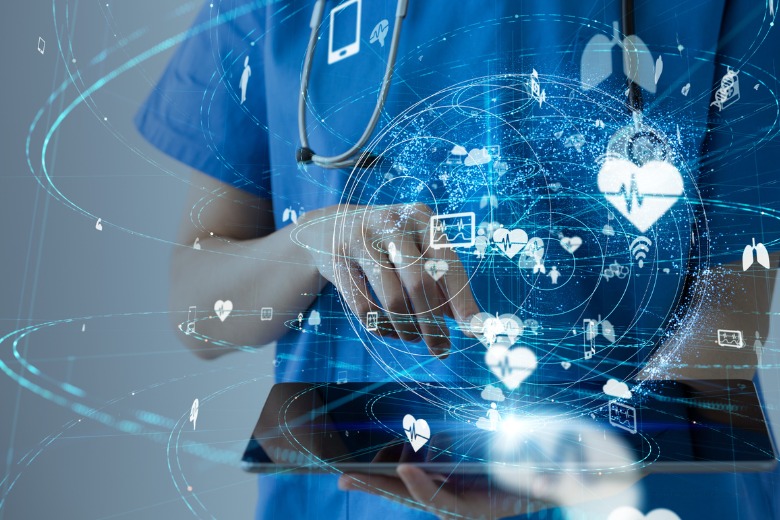
For decades, health systems around the world have been slowly digitising. That’s not news, but the recent acceleration of the pace of adoption is, writes Dr David Dembo.

This is especially the case in relation to three specific technologies: analytics, telemedicine, and telemonitoring. Pre-pandemic, digitisation of our health system was agonisingly slow, but with COVID-19 came a silver lining.
While understandable, it’s still frustrating that healthcare is the last bastion of industry to undergo a digital transformation, because most of the technology used to scale services in recent years have been around in other industries for decades.
Health systems digitise slowly because the costs involved are significant, and because the outcomes, just like the introduction of new treatments, must be proven along the way. But that proof now exists – data analytics, automation, and the Internet of Things (IoT) showed these health systems could keep functioning despite the surge in demand.
Data and analytics helped us predict who would be hospitalised and the demand for services based on infection rates and vaccine efforts. They helped us reboot elective surgery waiting lists between waves, based on priority and impact. Today, there are few medical practitioners or administrators not talking about data-informed decision making. Going forward, analytics and AI will continue to be core to how we diagnose, plan, and track the outcomes of our decisions.
Internet of Things
IoT started to become a reality at the turn of the century, both because of the number of connected devices and the range of data these devices could collect. Initially, clinicians were sceptical about the role IoT would play. We doubted the quality of the data and grossly underestimated patients’ willingness to be both recipients and participants in its development.
Initially, clinicians were sceptical about the role IoT would play. We doubted the quality of the data and grossly underestimated patients’ willingness to be both recipients and participants in its development.
Our change of heart was likely the result of the rising number of trials showing IoT’s clinical relevance and our own use of wearables as consumers and that we, clinicians, grew in confidence that these devices had a role to play. The groundwork had certainly been laid by the time COVID-19 hit and we needed to embrace telemonitoring models, where patients were being sent home with internet-enabled thermometers and pulse oximeters.
Previously, telemedicine companies had been doing it tough in the market, trying to encourage the uptake of this model of care. Largely helped by Australian governments’ willingness to fund telemedicine consults, COVID-19 massively accelerated the adoption of these consultations, a preference that will persist for many patients and clinicians where appropriate. We are finally delivering on the long-awaited ambition of providing care beyond the four walls of a hospital in an integrated and timely manner.
So, from the perspective of technology, I believe the last two years have improved our health system. It’s true that our health system is still only partly digitised and that not all data flows freely, but seeing what can be done with data, there is widespread acceptance that equity in patient outcomes and value-based care can only be achieved when clinical and administrative decisions are supported by data and analytics.
Future of the health care system
What does this mean for the future of our health system? I believe productivity and patient outcomes will improve as a result of the pandemic. We’ve shifted to a new data-informed model of care that better supports patients at home and now have better visibility on what happens in the community. This visibility, however, has highlighted the prevalence of healthcare inequity, which has exacerbated during the pandemic.
A report from the Australian Institute of Health and Welfare (AIHW) recently highlighted that impoverished Australians are four times as likely to die from COVID-19 when compared to advantaged groups. Public health experts have warned indigenous, disadvantaged and multicultural groups remain at greater risk with lower vaccine uptake.
I believe productivity and patient outcomes will improve as a result of the pandemic.
Before the pandemic, our health systems had little-to-no visibility once a patient left the GP practice or was discharged from hospital, meaning the majority of what happened in a patient’s recovery remained hidden from clinicians until the patient’s next appointment. Now we can see just how well, or poorly, patients are doing and respond accordingly.
Tragically, it was reported last year that by the end of September 2021, 38 people had died at home without hospital treatment, with a disproportional effect on people with non-English speaking and migrant backgrounds. This is where data-driven patient engagement tools and telemonitoring can make an impact.
From appointment reminders, personalised care plan instructions, reminders on medication dosage, these tools can deliver care and provide information to each patient based on age, weight, vaccination status, and underlying conditions, in hundreds of languages.
By providing patients with the right information at the right time, we improve patient experience and overall health outcomes. Additionally, when some of this communication is automated, we reduce the workload for constrained frontline workers.
We’re seeing huge investment from the Government into digital healthcare, including the $10 million investment into digital frontline care and $79 million to fund digital health tech development. This will create further impetus on digitisation and transparency giving visibility into the best – and worst – practices across the healthcare system.
We have wonderful opportunities ahead of us to capitalise on the unexpected surge in digital healthcare development. This is the time to acknowledge the resilience shown by our health workforce, and also to acknowledge the foresight and leadership shown by those who have invested in data-driven tools ahead of the curve.
*David Dembo is A/NZ director for Health Catalyst and a former ED physician
Comment below to have your say on this story.
If you have a news story or tip-off, get in touch at editorial@governmentnews.com.au.
Sign up to the Government News newsletter